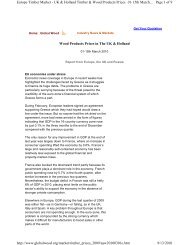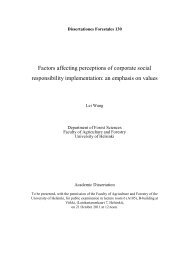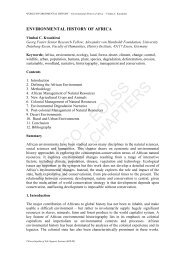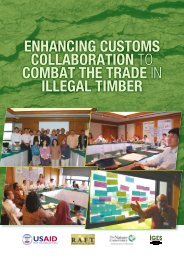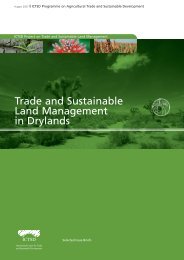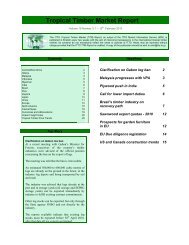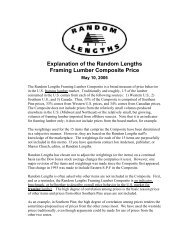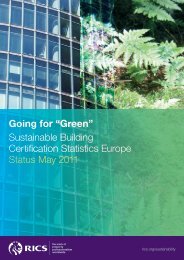ICT and e-Business in the Pulp, Paper and Paper ... - empirica
ICT and e-Business in the Pulp, Paper and Paper ... - empirica
ICT and e-Business in the Pulp, Paper and Paper ... - empirica
Create successful ePaper yourself
Turn your PDF publications into a flip-book with our unique Google optimized e-Paper software.
<strong>Pulp</strong>, paper <strong>and</strong> paper products<br />
4.1.7 Summary <strong>and</strong> conclusions<br />
The importance of st<strong>and</strong>ards <strong>and</strong> <strong>in</strong>teroperability for e-bus<strong>in</strong>ess is commonly<br />
acknowledged. 76 In <strong>the</strong> forest <strong>and</strong> paper products supply cha<strong>in</strong>, <strong>the</strong> papiNet® st<strong>and</strong>ard<br />
has been successfully established as <strong>the</strong> ma<strong>in</strong> <strong>in</strong>dustry st<strong>and</strong>ard for e-bus<strong>in</strong>ess.<br />
Even if papiNet® is by all measures a well managed <strong>and</strong> successful <strong>in</strong>itiative, <strong>the</strong>re is still<br />
a lot of scope for new implementations of this st<strong>and</strong>ard, especially for those <strong>in</strong>volv<strong>in</strong>g<br />
SMEs. Due to legacy factors <strong>and</strong> wide diversity of partners from different <strong>in</strong>dustries,<br />
implementation issues are not always straightforward. Currently, as <strong>the</strong> e-<strong>Bus<strong>in</strong>ess</strong><br />
Survey 2006 shows, only about 2-3% of firms <strong>in</strong> <strong>the</strong> P&P <strong>in</strong>dustry say that <strong>the</strong>y use this<br />
st<strong>and</strong>ard, <strong>and</strong> <strong>the</strong>se are ma<strong>in</strong>ly large enterprises (see Exhibit 3-8). However, <strong>the</strong>ir<br />
number as well as <strong>the</strong> amount of messages exchanged <strong>in</strong>crease fast (see Section 4.1.4).<br />
The strengths of <strong>the</strong> papiNet® organisation <strong>and</strong> its processes may have strong potential<br />
for similar cooperative developments <strong>in</strong> o<strong>the</strong>r sectors. In this sense, papiNet® could<br />
serve as role model. This study has identified some factors which have substantially<br />
contributed to <strong>the</strong> success of papiNet, <strong>and</strong> which could also be success factors for <strong>the</strong><br />
deployment of <strong>in</strong>dustry st<strong>and</strong>ards <strong>in</strong> o<strong>the</strong>r sectors:<br />
papiNet® Success Factors<br />
decentralised development <strong>and</strong> deployment: <strong>the</strong> implementation focus can<br />
differ between market segments <strong>and</strong> market areas, depend<strong>in</strong>g on <strong>the</strong> specific<br />
semantic issues that are most important <strong>in</strong> <strong>the</strong> segment/area;<br />
a clear messag<strong>in</strong>g <strong>in</strong>teroperability strategy, supported by a strong basis <strong>in</strong> stable<br />
message st<strong>and</strong>ards (ebXML);<br />
effective cross-sectoral partnerships, <strong>and</strong><br />
no certification overheads.<br />
To fur<strong>the</strong>r enhance this deployment, <strong>the</strong>re is an ongo<strong>in</strong>g requirement for good case<br />
studies on <strong>the</strong> practical benefits accru<strong>in</strong>g to SMEs that implement papiNet®. The case<br />
study on Stora Enso illustrated this po<strong>in</strong>t: <strong>the</strong> <strong>in</strong>itial excitement of smaller partners for<br />
papiNet® implementation is often dampened when <strong>the</strong> magnitude of <strong>the</strong> task relative to<br />
<strong>the</strong>ir exist<strong>in</strong>g software architecture is understood.<br />
In this sense, although papiNet® is universally recognised as be<strong>in</strong>g a very good st<strong>and</strong>ard,<br />
specific implementations (e.g. <strong>in</strong> particular market sub-sectors) do not always require all<br />
<strong>the</strong> data elements <strong>in</strong> <strong>the</strong> st<strong>and</strong>ard messages. In particular, hav<strong>in</strong>g to process a full<br />
general papiNet® message would be perceived as an “overkill” by those whose bus<strong>in</strong>ess<br />
management software consists of simple spreadsheet calculation. Thus, <strong>the</strong> fur<strong>the</strong>r<br />
deployment <strong>and</strong> broad adoption of such st<strong>and</strong>ards for e-bus<strong>in</strong>ess partly depend on <strong>the</strong><br />
<strong>in</strong>stalled base of bus<strong>in</strong>ess software systems, such as ERP systems. This aspect is<br />
discussed <strong>in</strong> more detail <strong>in</strong> <strong>the</strong> follow<strong>in</strong>g section.<br />
76<br />
See e-<strong>Bus<strong>in</strong>ess</strong> W@tch Special Report on Interoperability <strong>and</strong> St<strong>and</strong>ards, September 2005.<br />
Available at www.ebus<strong>in</strong>ess-watch.org ('resources')<br />
105



